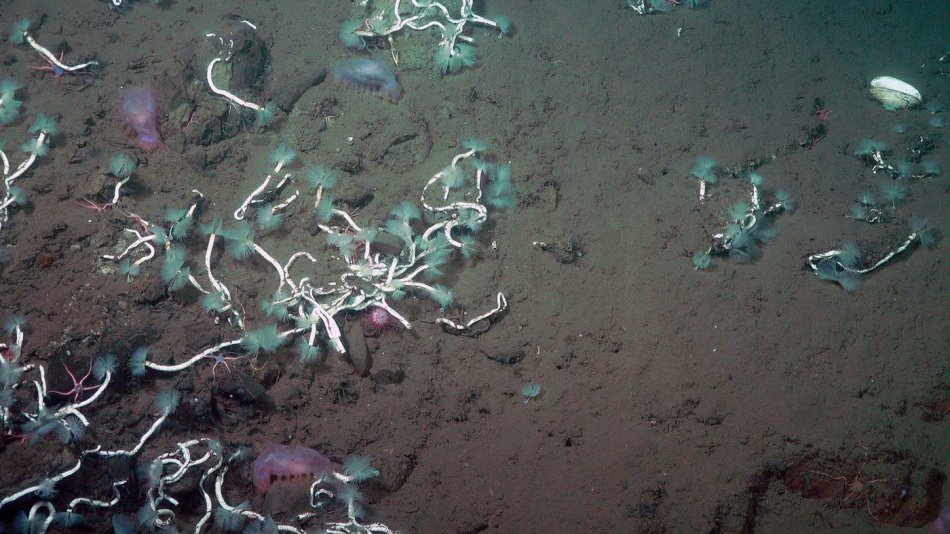Apr 6 2020
Researchers at Caltech and Occidental College have identified a methane-fueled symbiosis that exists between bacteria and worms at the seafloor, offering new insights into the ecology of deep-sea environments.
 Methane-consuming serpulid worms on the seafloor off the coast of Costa Rica. Image Credit: Alvin/WHOI.
Methane-consuming serpulid worms on the seafloor off the coast of Costa Rica. Image Credit: Alvin/WHOI.
The scientists discovered that bacteria that belonged to the Methylococcaceae family have been riding on the feathery plumes that serve as the respiratory organs of Bispira and Laminatubus worms. Methylococcaceae are methanotrophs, implying that they collect carbon and energy from methane, a molecule composed of hydrogen and carbon.
The worms, measuring just a few inches long, exist in huge numbers close to deep-sea methane seeps and vents in the ocean floor where hydrocarbon-rich fluids leak out into the ocean. However, it was not clear why the worms preferred the vents.
It was discovered that the worms gradually digest the hitchhiking bacteria, thereby consuming the energy and carbon harvested by the bacteria from the methane.
This process indicates that by getting a little help and some additional steps, the worms have turned out to be methanotrophs themselves.
These worms have long been associated with seeps, but everyone just assumed they were filter-feeding on bacteria. Instead, we find that they are teaming up with a microbe to use chemical energy to feed in a way we hadn’t considered.
Victoria Orphan, Study Co-Corresponding Author and James Irvine Professor of Environmental Science and Geobiology, Caltech
A paper related to the study of worms was recently published in the Science Advances journal on April 3rd, 2020.
Orphan and her collaborators discovered this at the time of research cruises to investigate methane vents off the coast of Costa Rica and Southern California.
We had a colleague on board who was an expert on these worms and noticed that the morphology was unusual. The respiratory plumes were much frillier than anyone had ever seen before, which was the first clue. It was enough to make us say, 'That's interesting. We should investigate.
Shana Goffredi, Study Lead Author and Visitor in Geobiology, Caltech
Goffredi is an associate professor of biology at Occidental College in Los Angeles.
To investigate the nature of the relationship between the bacteria and the worms, the researchers had to initially make use of robotic submarines to collect samples from deep-sea methane vents. In this case, the vents were located 1,800 m below the surface of the ocean.
As soon as the worms were brought to the upper surface, the researchers examined their tissues and cataloged the carbon isotopes that they had absorbed. Carbon occurs as two stable isotopic forms—different “flavors” of carbon, so to say.
About 99% of all carbon is carbon-12, the atomic nucleus of which consists of six protons and six neutrons, and about 1% is carbon-13 (with seven neutrons and six protons). Carbon-14 is a radioactive isotope that occurs in trace amounts.
Every organism needs carbon in some form or the other to survive, and it is absorbed via metabolic processes. Analyzing the ratio of carbon-13 to carbon-12 in the tissues of an organism helps to provide hints to where that carbon originated and the conditions under which it was developed.
The tissues of the deep-sea worms had an exceptionally low ratio of carbon-13 to carbon-12, implying that the carbon in the worm’s body possibly came from methane. According to Orphan and her colleagues, since the worms are not capable of handling methane directly, they must be absorbing carbon from methanotrophic bacteria.
The fact that we found this specific isotope of carbon throughout the worms’ bodies and not just in their respiratory plumes indicates that they are consuming methane carbon from these bacteria.
Victoria Orphan, Study Co-Corresponding Author and James Irvine Professor of Environmental Science and Geobiology, Caltech
The scientists followed up on this theory by making use of microscopy and molecular methods, as well as experiments, to test the capacity of these worms to include a traceable, altered version of methane.
The study outcomes alter the insights of seep ecosystems and are applicable to deep-sea stewardship, as methane oozes and hydrothermal vents will undergo rising pressure due to human utilization of minerals and energy.
The paper is titled “Methanotrophic bacterial symbionts fuel dense populations of deep-sea feather duster worms (Sabellida, Annelida) and extend the spatial influence of methane seepage.” The co-authors from Caltech are graduate student Sean Mullin and postdoctoral researcher Fabai Wu.
The other co-authors of the study are Ekin Tilic, Lisa Levin, and Greg Rouse of Scripps Institution of Oceanography in San Diego; Katherine Dawson of Rutgers University in New Jersey; Abigail Keller and Erik Cordes of Temple University in Philadelphia; and Raymond Lee of Washington State University.
This study was financially supported by the National Science Foundation and the Gordon and Betty Moore Foundation.
Exploring Methane Seep Ecosystems with Victoria Orphan
Video Credit: Caltech.